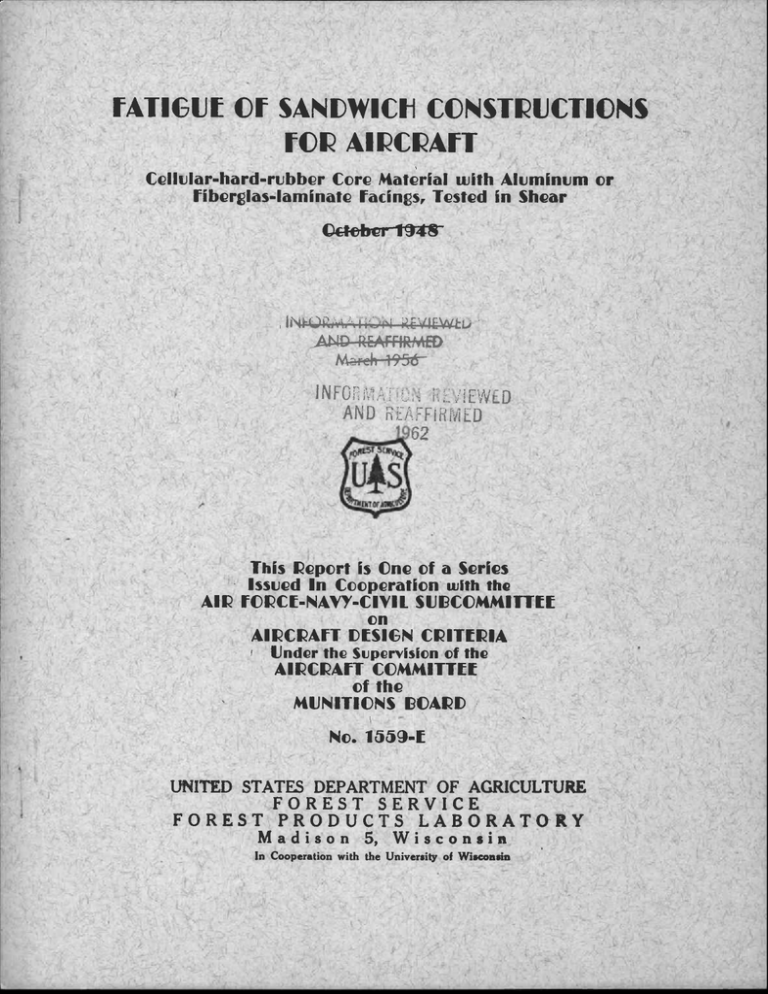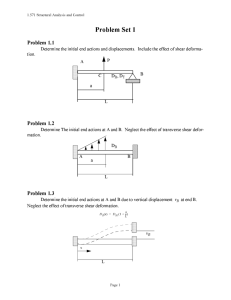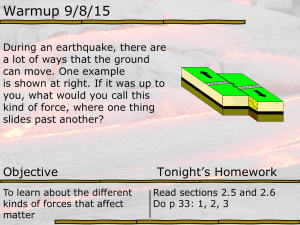FATIGUE OF SANDWICH CONSTRUCTIONS FOR AIRCRAFT
advertisement

FATIGUE OF SANDWICH CONSTRUCTIONS FOR AIRCRAFT Cellular-hard-rubber Core Material with Aluminum or Fiber:gas-laminate Facings, Tested in Shear ectelwr-19415" ZEVIEVVkt, • JUsil)—REAFFIRMED M4,-.4t4r—t95.15— D AND REAFFIRMED 62 This Report is One of a Series Issued In Cooperation with the AIR FORCE-NAVY-CIVIL SUBCOMMITTEE on AIRCRAFT DESIGN CRITERIA Under the Supervision of the AIRCRAFT COMMITTEE of the MUNITIONS BOARD No. 1559-E UNITED STATES DEPARTMENT OF AGRICULTURE FOREST SERVICE FOREST PRODUCTS LABORATORY Madison 5, Wisconsin In Cooperation with the University of Wisconsin FATIGUE OF SANDWICH CONSTRUCTIONS FOR AIRCRAFT1 (Cellular-hard-rubber Core Material with Aluminum or Fiberglas-laminate Facings, Tested in Shear).? By FRED WERREN, Engineer Summary and Conclusions A limited number of tests (46) have been made at the Forest Products Laboratory to determine the shear fatigue properties of an assembled sandwich panel of cellular-hard-rubber core material and aluminum or fiberglaslaminate facings. The tests have been made at a ratio of minimum to maximum loading of 0.1. The results of these tests and the corresponding S-N curve are presented. The results of the tests indicate a fatigue strength at 30 million cycles of approximately 44 percent of the static strength for the condition of loading used. Introduction Experiments were conducted at the Forest Products Laboratory to determine the shear fatigue characteristics of typical sandwich panels having cellular-hard-rubber core material. The facing materials employed were 1 –This progress report is one of a series prepared and distributed by the Forest Products Laboratory under U. S. Navy, Bureau of Aeronautics No. NBA-PO-NAer 00619, Amendment No. 1, and U. S. Air Force No. USAF-PO(33-038)48-41E. Results here reported are preliminary and may be revised as additional data become available. 2 –This is the sixth of a series of reports intended to offer a comparison of the shear fatigue pro perties of different sandwich materials. The following Forest Products Laboratory reports have been completed: 1559 - "Cellular Cellulose Acetate Tested in Shear" 1559-A - "Aluminum Face and Paper Honeycomb Core Sandwich Material Tested in Shear" 1559-B - "Aluminum Face and End-grain Balsa Core Sandwich Material Tested in•Shear" 1559-C - "Fiberglas Honeycomb Core Material with Fiberglas-laminate or Aluminum Facings Tested in Shear" 1559-D - "Fiberglas-laminate Face and End-grain Balsa Core Sandwich Material Tested in Shear" Rept. No. 1559-E (1) 0.020-inch aluminum bonded to the core with a room-temperature-setting resorcinol resin, adhesive ir .,2 and (2) six-ply fiberglas laminate impregnated with a high-temperature-setting laminating resin, resin A. The general testing procedures and the nomenclature applied to these tests are similar to those used by the Forest Products Laboratory in testing aluminum face and paper honeycomb core sandwich material .2 Description of Material and Specimens -The cellular hard rubber was received from a commercial manufacturer in blocks approximately 1-1/2 by 20 by 36 inches. The blocks were sawn 'parallel to the longest side into strips about 5 inches vide. These strips were further finishe4 by sawing into strips 0,500 ± 0.005 inch thick as described elsewhere.i Five 1/2- by 5- by 25-inch strips were edge glued together to forma finished core. Two panels with aluminum facings were prepared and bonded in a press as described in method 2 of aluminum-to-cellular-hard-rubber assembly techniques, Forest Products. Laboratory Report No. 1574.1 One panel with fiberglas facings was made in a press by the methods described in the same report. The facings were made of six plies of cross-laminated glass cloth impregnated with 45 to 50 percent of resin A by weight. The specimens were cut from the assembled panels with a high-speed steel circular saw to a width and length of 2 and 5.67 inches, respectively. With the exception of specimens designated with an "a," the specimens were cut parallel to the direction of the core strips so that no part of the core-to-core glue line was included in the specimen. Some specimens from panel A2-7 were cut perpendicular to the core-to-core glue lines and thus include at least one such glue line. These specimens were lettered with an "a." The specimens with aluminum facings were glued to the 1/2 inch sheaf plates as described in Forest Products Laboratory Report 1559-A, except that the secondary adhesive was adhesive N, cured at 15-pounds-per-squareinch pressure at 180° F. for 1 hour. Specimens with fiberglas-laminate facings were glued with adhesive M primary and adhesive N secondary and cured as above., The results of 46 fatigue tests and 30 control tests are presented in this report. The resins, adhesives, and core material referred to in this report are described further in appendix 1. F orest Products Laboratory Report No. 1574, "Fabrication of Lightweight Sandwich Panels of the Aircraft Type," by B, G. Heebink, June 1947. Rept. NO, 1594.11 Testing All tests were made by methods similar, to those described in Forest Products Laboratory-Report No. 1,59-AS the basis of the method of manufacturing the cellular hard rubber, it would seem likely that the shear properties of the sandwich panels would be similar in the planes parallel to the facings. This probability was confirmed by a few tests on panel A2-7, where the properties of a few specimens taken at right angles to the others appeared to be very nearly the same. On Tests of sandwich specimens with cellular-hard-rubber core presented Many difficulties in fabrication,'cutting, and testing. The brittle nature of the material, 'the variation in density, and the low proportional limit ip Compression at elevated temperatures_ were among the factors complicating the experiments. The wide scatter of test results, both in static and fatigue tests, was in part due to these factors. It is difficult to detect minute fractures caused by fabrication or to observe and correct for variations of density, and since even the low pressures at elevated temperatures used in gluing the specimens probably exceed the compressive proportional limit, it is impractical to make corrections for the possible damage incurred. Failure of control and fatigue specimens was rapid once failure had begun. In all cases, the failure occurred in the core near the glue line. Typical control failures are shown in figure 1. The left specimen is representative of shear failure in the core with one diagonal tension break. The right specimen similarly represents a shear failure of the core, but the ridges indicate a greater tendency toward diagonal tension failure. There was no discernible difference between the failures of the control and fatigue specimens. Presentation of Data Table 1 presents the results of the individual control and fatigue tests. Values are calculated as in Forest Products Laboratory Report No. 1559 .4. The control Strengths varied from 84.6 to 159.7 pounds per square inch, and indivridual control strengths within a group varied as much as 6 percent.from the average. • The results of the fatigue tests are plotted in figure 2, and the S-N curve to drawn through the average values. Analysis of Data The scatter of points around the S-N curve may be attributed principally to the variation of the core material. With the large differences Rept. No. 1559 -4 '.3, of control values within a group, as shown in table 1, a considerable scatter of fatigue data must be expected. It had been previously agreed to discontinue.any , specimen that withstood 30 million cycles without failure, so that this discontinuance, combined with the large variation in test'results, makes it difficult to predict theiendurance Howeiver,a curve hat,been,drawn_through the plotted data (fig. 2) and shows the trend of the fatigue;, haraCteristicsof these sandwich. materials. When a lightweight. core material, such as cellular:hard,rubberit,glued to a rigid face and then is subjected to shear stresses, a zone of stress concentration must be expected:neer The primary failure Of all fatigue and! control-. specimens' tested for thlireport:wat,a, shear fallureof the core near and parallel to , the;glue;line. In-some cases: there was additional!evidenceof diagonal tension,failurtw ,Since there was nofailure'of the glue line, itself, it: may beconcluded that the adhesion between the facings:and core-was satisfactory. APPS pa 1 Description of Resins Adhesives, and Core Material Adhesive V. A room-temperature-setting resorcinol Resin: A. resin. A high-temperature-setting, high-viscosity, contact-pressure; laminating resin of the polyester type. Adhesive M. A high-temperature-setting mixture of thermosetting resin and synthetic rubber. Adhesive N. Cellular A high-temperature-setting, acid-catalyzed, phenol resin. herd rubber,. A core material, black in color, of. approximately 8-Pounds . per-oubierfoot density (including skin). Rept. NO. 1559-E Table 1.--Shear fatigue strength of sandwich constructions having cellnlar-hard-rubber cores and aluminum or fiberglas-laminate facings Patigue tests Specimens Maximum t Control : Ratio of : No. t repeated: strength : maximum I t sheer t I repeated : : stress I :stress to : t : control : t : t strength ; 1 1e ''t (1) 1 (2) t -....., : : (3) : t (4) : t Cycles to failure : Control teats t 1 Specimen t Shear t No. - strength 1 in t . core : t t .. : (5) : :t P.s.i. : P.s.i. : Percent Visible failure (6) t (7) r (8) -1 1 t t P.s.i. Sandwich Material of Cellular-hard-rubber Core and Aluminum lacings A2-6-1 r 4 : 58.2 : 90.0 t 112.0 6 t 96.0 : 3 : t 132.2 132.2 132.2 : : 44.o : 15,914,400 68.1 : 72.6 1 132.2 84.8 132.2 132.2 132.2 g : 55.2 : : 1 74.9 : 6,300 132.2 132.2 : : 45.0 1 6,966,000 65.0 t : 1 7 9 : 73.o • 76.0 12 : 99.0 : 1 1 : : : : 59.5 13 15 16 : 93.9 : 86.0 . .1.2- 6- 18 19 21 : 132.2 : : : 79.8 t : : : 57.5 : 71.0 1 s : 57.3 : 83.9 50,700 1 1 102.2 102.2 : . 4,400 •7,600 1,390,800 22,000 5,500 23,400 979,100 15,200 t 102.2 ; 78.1 107.8 . 47.3 : : A2-6-2 : 127.2 1 1 5 Shear and . : 159.7 8 : 140.2 11 : 110.3 : diagonal tension : : Shear 14 : 123.6 • do : : Shear and : Average... 132.2 : diagonal teneion t :....do : Shear : Shear 1 and 1 1 t diagonal tension : s : : 56.1 82.1 : Shear t. ...do 1. .do 1,700 : Shear t Shear and : diagonal : Shear r A2-6-17 : I . 99.9 20 : 106.1 tension I • 23 : 100.6 : Average... 102.2 ♦2-7-1 : : : 51.0 : 81.0 . 3 4 6 7 9 : : : : . 52.5 46.5 60.0 49.5 .0 : 48.4 : 48.0 I 57.0 16 : 75.0 107.8 . 107.8 1 46.0 107.8 107.8 107.8 107.8 : : : : : 50.1 44.9 44.5 52.8 I : 69.5 : : : 105.4 : 53.1 • : 68.0 43.2 55.6 107.8 105.4 105.4 : : 105.4 58.8 105.4 105.4 : : 15a : 53.0 16a : 74 . 0 16 : : 105.4 105.4 : 38.9 44.6 47.4 105.4 13a : 80.0 12a : I : : 9a : 50.0 : 10a : 62.0 48.7 : : s : : . 41.3 7a : 47.o 75.2 : : 6a : t 107.8 107.8 : A2-7-4a : 56.0 : : : i 10 12 13 15 107.8 64.5 75.9 50.3 70.2 s 19a t 98.8 21a : 100.0 : : 105. 105.4 N.79 1,804,600 : Shear I A2-7-2 : 112.8 1 : Shear and 5 I 110.5 : diagonal tension : g : 602,400 t Shear : 8 : 99.0 : 18,540,500 • ..do : 101.7 11 : 22,900 • .do 14 1 135.6 : : Shear and 912,000 : 17 : 99.2 s : diagonal tension o : 60,200 : Shear : 19 : 96.0 : 2,727,900 :....do : 30,164,300+ : No failure ! Average... 107.8 : 258,600 : Shear and . : diagonal tension : : 174,200 :....do : : 1,300,900 : Shear : k2-T-2a : 95.5 : 33,118,300+ : No failure 5a : 94.1 : 30,681,404 8a t 103.7 : 1,132,100 :Shear and lla : 111.55 1 diagonal tension : 1 : 94,600 : Shear i 14a : 101.2 : :. ..do 248,200 17 a a 108 . 1 56,700 : Shear and 20a : 114.6 : : diagonal tension : : : 2,495,500 : Shear : 23a : 114.2 : 371,700 : Shear and : ; : diagonal tension : Average... 105.4 4,30o :....do : 20 1....do t : 900 t Sandwich Material of Cellular-hard-rubber Core and Piberglas-Laminate Facings P2-1-1 : 47.2 i 6 t : : t 53.0 1 7 9 106.0 65,7 106.0 1 2 1 1 10 1 48.8 I 44.5 : 106.0 106.0 106.0 1 : I 1 ; 42.0 : : : 45.6 63.6 78.5 16 2 1 1 61.5 70.0 • I . 44.5 50.0 6203 70.0 106.0 : 46.0 106.0 106.0 106.0 1 43.0 t : I 106.0 106.0 : g t t t : 1,791,700 : Shear and t 72-1-2 : 110.5 : diagonal tension 1 s : No failure 5 1 814.6 t 9,742,500 : Shear 1 8 1 125.2 t 2,588,700 t ..do : 11 1 95.5 a 1,500 t.. .do : 14 1 103.9 : 6,186,9oo : Shear and : 17 : 109.9 : diagonal tension : : 1 38,808,900+ : No failure : 20 : 115.3 : 31,800 a Shear . r : 16,200 : Shear and : Average... 106.0 t : diagonal tension : t 618,600 1....do • 43,000 : Shear : i I 12 13 15 : : 60.0 74.0 58.o 66.0 t 33,765,400. 1 -4btigue specimens loaded at rate of 900 cycles per minute in direct-stress fatigue machine. Ratio of minimum to maximum load was 0.10. Control specimens tested in a hydraulic testing machine at a head speed of 0.01 inch per minute. Z M 78503 F Z M 79243 F Figure 1.--Typical failures of control specimens from aluminumface and cellular-hard-rubber-core sandwich panels. S.? 03 I R. cd 0 El •-I •-n ti C..) 0 o • a o .0 0 O u) 4-4 N o En +.1 N rn C • 0 CO ••-1 be U 141 OO cd 4-1 (.21 • * 0 0) 0 4) cd 0 0 IR VC 'IzE o (41 a) 0 0 7 7 Lk4.1 0 • q ki S 70,14LA/0.2 d0 1N3.983c/ SS3815 031V3c/34/ Amami t.. CD Z • 60 03 3. rn CD ,0 1.• ,0 0 0 .0






